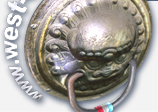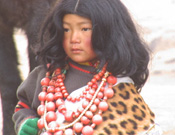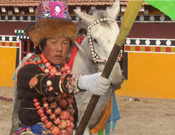|
16 Days Tibetetan Khampa Horse Race Festival & Textiles Tour
in Eastern Tibet
Day 01
This afternoon we depart Home on the Air China flight to Beijing,
flying overnight.
Day 02.
Following our early afternoon arrival we will be met and transferred
the centrally located 4* Hotel. The remainder of the afternoon is
leisure.
Day 03. – Beijing
/ Lanzhou / Xiahe
After breakfast we will be collected from the hotel for the morning
flight to Lanzhou. You will be met on arrival and after lunch continue
the journey by bus to Xiahe. As we approach Xiahe we leave the open
countryside of wheat and melon fields and the Muslim villages with
their mosques. Xiahe is at the start of our Tibetan travels here
we find the important yellow sect monastery of Labrang which is
still the home of over one thousand monks. Its great assembly hall
and related schools, surrounded by those living monks’ quarters
stretching along the valley is surrounded by the sacred way lined
with thousands of prayer wheels. Overnight Overseas Hotel or other
better hotels.
Day04 -- Labrang Monastery
We visit Labrang Monastery in the morning. Our Tibetan guide will
show us the impressive interior of the Assembly hall and other temples.
We will be introduced to the Buddha images and numerous protective
deities. The importance of textiles on the interiors and exteriors
of the monasteries will be brought home to us. exploring the Tibetan
antique shops as well as the shops providing for the needs of monks
and the monastery. One finds for sale religious thangkas, Buddha
statues, prayer flags, a range of monks clothing, rolls of cloth,
hand-printed sutras as well as a nomadic jewellery. Many of the
shopkeepers are Muslims, know locally as Hui Hui, so bargaining
is the order of the day.
Day 05. --Labrang /
Tongren (Repkong)
After breakfast, we drive 130km about 3 hours to Repkong (Alt: 2400m).
On the way, we pass grassland, forestry, agricultural land and beautiful
Red Mountain valley. Tongren was in the past and is still today
one of the most famous central of Tangkha painting as well as the
making of appliqué Tangkhas. We have asked local people to
demonstrate these two arts, as well the making of clay sculptures.
In the area there is a famous hat maker who makes the yellow hats
for the yellow sect monks and lamas. This is a particularly interesting
craft, which we also hope to see. Other members of the family will
show us monk robes and cloaks so we have some idea of the huge amount
of work that goes into the making of these clothes. There will be
visits to small monasteries in the area like Sengeshong Mango sang
and Guomar etc. to have an opportunity to wander in the villages
of the Tibetan and Tu farmers who are not nomads but arable farmers
growing the important crops of wheat and barley that is the staple
food of all Tibetans. The valley at this time of year will be a
sea of longhaired barley surrounded by sand brown eroded hills with
single storied villages tucked into the hillside. It is a beautiful
scene. Overnight Telecommunication Hotel **
Day 06. --Tongren /
Jentsa
Today we drive 110km to Jentsa County which straddles the Yellow
River. Originally this was a Tibetan area but Hui Muslims traders
and farmers have recently to settle in the county. However, important
Tibetan monasteries still remain in the area and we are visiting
Achung Namdzong Red Sect Monastery, which is surrounded by beautiful
mountain peaks and is in the middle of Khamra National Park which
is a spectacularly forested region. The monastery has strong connections
with Padmasambhava and the area has been a place of pilgrimage since
the 8th century. Sadly many of the temples still need restoration.
Nearby, Chorten Tang the biggest nunnery in Amdo houses 200 nuns.
We plan to visit it. Road construction has finished so it is now
possible to visit both areas and then drive to the Lijiaxia Hydro
Power Station hotel to overnight
Day 07.
It is an interesting drive for 320km to Maqen (Machen), the Tibetan
Golok capital. The Goloks in the past were the most feared Tibetans,
as they made their living from plundering the caravans that passed
on through their way from Xining to Lhasa. We encounter a great
variety of landscapes, from a sea of sand with huge dunes and a
heavily eroded landscape of strange shapes, to pastureland, where
nomads can be seen herding their flocks of sheep, living for the
summer in black yak hair tents. We will stop at a monastery en route
and admire the huge lhatses of coloured flags and spears, refurbished
every year by the men of the family in honour of the Mountain Gods.
The altitude is higher at 3800m here but we shall be acclimatized
as we have driven slowly higher.
Day 08. --Machen
Today we travel a short distance out of town to have a view of the
holy mountain of Amnymachen which is revered by the Bonpo and Buddhist
alike. It is also the home of the sacred protector of the Gologs,
Machen Pomra. It was suggested up to 1949 that the holy mountain
was the higher, even than Everest, but the height was finally fixed
during the 1960’s at 6282m. If it is a clear day we shall
have a splendid view of this superb peak. Although you can make
pilgrimages round this holy mountain we will leave it for another
time, as it takes eight days and is very tough walk which is better
left to the very fit. Then we plan to visit an encampment of Tibetans
and we have arranged to see some nomadic families as well as having
an opportunity to see the tents interior and perhaps eat yak yoghurt
with the nomads. On the retune journey we will call in at a great
assemblage of flying prayer flags that stretches over the mountainside.
The site is sacred and we shall see local pilgrims walking round
the flags with their prayer wheels turning. Local craftspeople carve
rocks with the sacred words Om Ma Ni Padmi Hom which translated
means hale to the jewel of the lotus. One can buy these beautiful
souvenirs from this deeply religious community. Overnight local
best hotel with facilities in the rooms.
Day 09. --Machen /
Madoi
It is a day of wonderful skyscape and rolling pastureland, grazed
by sheep and yaks. A picnic on the open plateau among the wild flowers
is just perfect. Madoi (Mato), where we stay, stands at approximately
4200 meters is one of the highest points on this journey. It is
an outback frontier town and is an administrative centre for the
Golok prefecture. This is the most testing hotel and there are no
private facilities but the rooms are clean and warm and the food
is fine. It can be very cold on the windswept plateau and white
clouds scud across the blue sky sometimes changing to grey which
can even mean the occasional snow storm, which passes as quickly
as it came.
Overnight local best hotel.
Day10. --Madoi / Yushu
Starting early we travel 360 km to Yushu (Jyekundo), which stands
at 3, 700 meters. En route we pass the first bridge of the Yellow
River, the famous mountain pass Bayankala at elevation 5080m and
upper reaches of the Yangtze River, there are also a lot of black
yak wool tents, flocks of horned sheep and huge yak herds. Prayer
flags flutter as we pass towns and villages. We stop to see rare
yellow and blue poppies on high mountain passes as well as water
meadows rich with flowers. Lunch is at a typical frontier town and
we will probably see nomadic girls wrapped in wool chubas wearing
yellow amber pieces on their long black hair contrasting with blue
turquoise. As we approach Yushu the hills are a rich green and we
note a number of monasteries, perched high on the cliff face, painted
in earth colours to our right. Yushu is the capital of the Yushu
Tibetan Autonomous Prefecture and this region is known for the monasteries
belonging to Sakaya and Kagya sects. Overnight Yushu Hotel***
Day 11.12.13. Yushu Horse Festival
Our arrival coincides with the opening of the Yushu Horse Fair and
on the first day there is a huge parade of the participants which
includes the dance teams, horse riders, the monastic communities
dressed in their ceremonial clothes, the local schools, the services
and the army. It is a riotous display of colour and beautifully
costumed. Flags fly and the Tibetans dance vigorously to the music
with their feet stamping in time. Ankle bells jingle. There is a
huge programme of events for the next three days and we pick and
choose. The favorite events are always the acrobatic riding and
target shooting from horseback and the dancing. The Tibetan families
live on site, at the time of the fair, in huge white canvas tents
decorated with appliqué designs. It is enormous fun to wander
round and meet the Tibetan families who nearly always invite you
into their tents to picnic from the huge quantities of food, which
has been brought with them. Yoghurt and cold lamb with fried breads
are some of the favorites, washed down with quantities of beer and
chang. Most people are wearing their regional costumes and the women
wear their richest turquoise, amber and coral jewellery and exotic
hairstyles. There is also a thronging market on site, which is well
worth exploring.
We also visit some of the local monasteries in the area and picnic
with a nomadic family. Horse gear is made from sheep and yak wool
and many of the men are very clever at braiding. Some of the braids
collected from here have been very much admired by specialists in
the field. We hope to get a demonstration as well as a weaving demonstration
on the nomadic ground looms. Men and women still make storage bags,
tent panels, horse-harnesses and slings. There is time to photograph
meadow flowers which are particularly stunning in this area.
The centre of the town has a number of textile shops where you can
buy local materials used by the Tibetans to make their traditional
colourful costumes. There are also a few shops where you can buy
antique Tibetan items.
Day 14. --Jyekundo
/ Xinghai (Tsigortang)
Today we have to leave early in the morning, maybe at about 7:00am,
because of a long day driving and we have a picnic breakfast on
the way. We may spend 10 hours on the way including the stops time
of breakfast, lunch, and photos and stretching your bodies at the
spots with beautiful landscape. On the way we may see some wild
animas, Black necked cranes, crows of wild Asses and gazelles, deer,
different species eagles. Xinghai local best hotel, rooms with facilities.
*
Day 15. -- Xinghai
/ Kokonor /Xining
Day 16. -- Xining / Beijing
After breakfast we will be collected from our hotel and transferred
to the airport for the flight to Beijing .On arrival we will be
met and transferred to the hotel. The remainder of the afternoon
is at leisure allowing you time to relax, visit some of the local
sites or do some shopping. Dinner will be include, a Peking Duck
Banquet. Overnight a good 4 star hotel
Day 17.
Transferring to International Airport to take flight back home.
|





